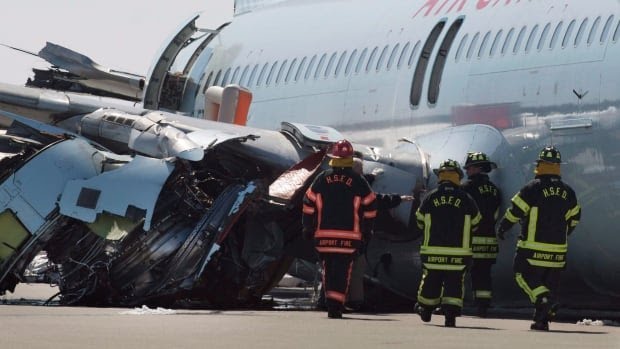
Canada’s air safety agency says passengers continue to slow down emergency aircraft evacuations by stopping to grab their personal belongings, despite the warnings it has issued since 2007 about the dangers.
But Transport Canada is resisting a longstanding recommendation that flight safety briefings for passengers include mandatory warnings against collecting carry-on bags and electronic devices in the event of an emergency.
The grab-and-go hazard was cited earlier this month by the Transportation Safety Board of Canada (TSB) in its report on a Jan. 5, 2018 fire aboard a WestJet plane on the tarmac at Toronto’s Pearson International Airport.
“During the evacuation, the FAs [flight attendants] issued instructions … telling the passengers to leave all their carry-on baggage behind,” says the report.
“Despite these instructions, numerous passengers brought carry-on baggage with them, which slowed down the evacuation process.”
The incident is at least the third in Canada since 2005 which led the agency to warn of the dangers of airline passengers collecting their possessions before moving toward the exits.
In August, 2005, passengers on a jet that overshot the runway at Pearson grabbed their carry-ons, ignoring the flight attendants’ contrary instructions. The same thing happened after an Air Canada crash at Halifax airport in March 2015, the agency said, calling the practice “widespread” around the globe.
Since 2007, the Transportation Safety Board has pressed Transport Canada to require airlines to specifically warn passengers about the dangers of grab-and-go — in pre-flight safety briefings or pre-landing briefings, in safety cards or during emergencies themselves.
ADVERTISEMENT
Transport Canada has declined to do so. Instead, it has issued notices encouraging airlines to voluntarily alert passengers to the dangers. The TSB now officially lists its recommendation as “dormant” because of Transport Canada’s reticence.
Random survey
The TSB’s probe of the Jan. 5 incident at Pearson included a small, random survey which involved investigators silently observing actual safety briefings for regularly scheduled flights on several airlines, and listening for standard warnings against grabbing carry-ons during emergency evacuations.
“None of the briefings on the observed flights provided this type of instruction to the passengers at any point before or during the flight,” says the report.
The international rule-of-thumb for emergency aircraft evacuations is that everyone — passengers, cabin crew and air crew — must be out of the plane within 90 seconds. After that point, the risks of toxic gas leaks and fire increase quickly.
A TSB official said passengers who stop to collect personal belongings pose a threat to everyone.
“You’d think one bag would only slow it two seconds, but it doesn’t really. It’s a cascading sort of effect,” said Ewan Tasker.
In April of this year, even before receiving the TSB report on the Jan. 5 incident, Transport Canada re-affirmed its policy that lets airlines decide whether to include the warning in their safety messages.
“Building on previous successes and experience in influencing positive changes in airline/air carrier safety practices in airlines, to address this issue, the department will use a combination of education and awareness,” says a plan approved by Transport Minister Marc Garneau on April 30.
The department apparently wants to avoid being out of step with Australia, the United States and the European Union, where airlines are not compelled to provide the warning in safety briefings.
Transport Canada spokesperson Daniel Savoie did not respond directly when asked why such warnings were not mandatory, saying only that the department recommends them.
The department issued a safety alert on April 13, acknowledging that its previous reminders to airlines on the issue have “not been effective” and again encouraging them to find solutions.
ADVERTISEMENT
Transport Canada also plans a year-long “inspection campaign,” starting in October, to see whether airlines are responding to the non-mandatory guidelines, says a briefing note obtained by CBC News under the Access to Information Act.
The department will then “evaluate [the] results of [the] inspection campaign to determine if additional risk mitigation action is required.”
WestJet spokesperson Lauren Stewart said the airline “will be including the language around leaving carry-on baggage during an evacuation in our passenger safety briefings later this fall.”
Air Canada spokesperson Isabelle Arthur said such a warning is included already in a safety demo video passengers view before takeoff, described in pictures on a safety card in every seat pocket, and repeated by flight attendants during emergencies.
Seconds lost
A spokesman for unionized flight attendants in Canada said the problem has been made worse by the increasing number of expensive electronic devices now carried by passengers, and by new rules that are reducing the required number of flight attendants for each flight.
“We are the last line of defence before you go down the [evacuation] slide,” said Jordan Bray-Stone of CUPE, which represents some 10,000 cabin crew members at most of Canada’s larger airlines.
ADVERTISEMENT
“Every time we have to tell someone [to abandon their carry-ons] in an evacuation, it eats up some precious seconds … Ninety seconds is not a long time,” he said from Montreal.
“It’s a very selfish mode that people go into, to get our little gizmos and bags out of the overhead bins.”
Bray-Stone said mandatory safety briefings referring to personal belongings can help — though he added that many people ignore such briefings altogether.
More can be done, he said, including inserting such safety messages just before the start of in-flight entertainment segments — “at a time when they aren’t expecting it.”
Transport Canada’s Savoie said the department has “elected to use social media and other forums to emphasize to Canadians that carry-on baggage must not be taken in an emergency situation.”